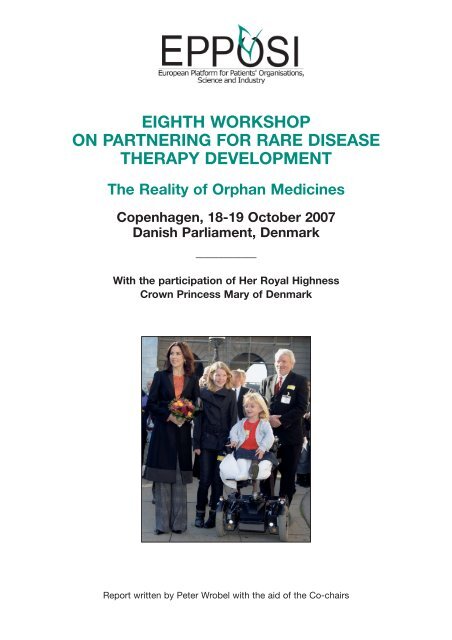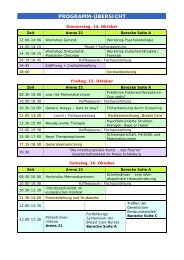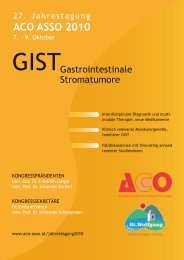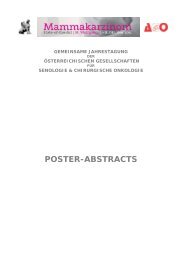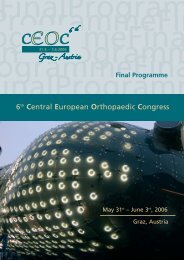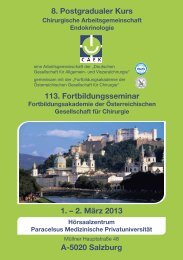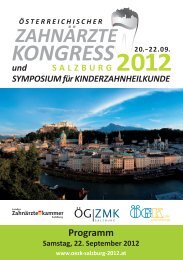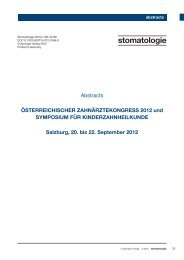Report Copenhagen - Vienna Medical Academy
Report Copenhagen - Vienna Medical Academy
Report Copenhagen - Vienna Medical Academy
Create successful ePaper yourself
Turn your PDF publications into a flip-book with our unique Google optimized e-Paper software.
EIGHTH WORKSHOP<br />
ON PARTNERING FOR RARE DISEASE<br />
THERAPY DEVELOPMENT<br />
The Reality of Orphan Medicines<br />
<strong>Copenhagen</strong>, 18-19 October 2007<br />
Danish Parliament, Denmark<br />
————————<br />
With the participation of Her Royal Highness<br />
Crown Princess Mary of Denmark<br />
<strong>Report</strong> written by Peter Wrobel with the aid of the Co-chairs
Eighth EPPOSI PRDTD Workshop - <strong>Copenhagen</strong> 2007 2<br />
• The report and its aim<br />
• 1. How to estimate the value of an orphan drug<br />
• 2. How many orphan drugs – for how many patients?<br />
• 3. How to communicate about orphan drugs in a real-life setting?<br />
This event was kindly sponsored by: Actelion, Baxter, BioMarin, Celgene, Genzyme,<br />
GlaxoSmithKline, Merck-Serono, Novartis, Novo Nordisk, Pfizer, PharmaMar, Shire HGT<br />
Swedish Orphan International<br />
Contributors: Integral, Zymenex<br />
Supporting organisations: EuropaBio, European Biopharmaceutical Enterprises (EBE),<br />
European Genetic Alliances’Network, EURORDIS, Orphanet, Sjaeldne Diagnoser, Stuurgroep<br />
Weesgeneesmiddelen<br />
<br />
The Co-Chairs with the Director and the Chairman of EPPOSI<br />
S. Aymé, E. Tambuyzer, G. Asta, B. Holm, A. Kent<br />
Cover picture : HRH Crown Princess Mary of Denmark, Kristine, Mari, Alastair Kent
3 Eighth EPPOSI PRDTD Workshop - <strong>Copenhagen</strong> 2007<br />
The report and its aim<br />
This publication is a report of the Eighth<br />
EPPOSI Workshop on Rare Disease Therapy<br />
Development and Partnering, held on 18 and<br />
19 October 2007 in the Danish Parliament, in<br />
<strong>Copenhagen</strong>.<br />
The starting point for the workshop was simple:<br />
patients with rare diseases have no choice<br />
over their disease but are as entitled to a treatment<br />
as patients with more common conditions.<br />
The aim was to build a platform for<br />
consensus on what can be done, rather than to<br />
establish an artificial one in an area where there<br />
are many viewpoints and too few data. This<br />
short report, accordingly, is not intended to be<br />
a consensus view. Rather, it seeks to highlight<br />
the main points that emerged during two<br />
intense days of discussion and debate. The<br />
rapporteur, Peter Wrobel, takes full responsibility<br />
for this work.<br />
What is a rare disease?<br />
A rare disease is a life-threatening or chronically debilitating<br />
condition affecting not more than five in 10 thousand<br />
(or 1 in 2 thousand) persons in the Community.<br />
Source: Reg EC 141/2000 of the European Parliament and of<br />
the Council of 16 December 1999 on orphan medicinal<br />
products.<br />
Executive summary<br />
What is the reality of orphan medicines in<br />
Europe? The truth is that no one really knows<br />
the full picture. It is hard enough to find out<br />
which medicines are actually on sale in which<br />
European countries, and equally difficult to say<br />
how many patients could benefit from orphan<br />
medicines. When it comes to saying how many<br />
orphan medicines may be on the market in five<br />
or ten years’ time, or how large the potential<br />
market is for these medicines, there is too<br />
much guesswork operating.<br />
In this uncertain climate, three approaches are<br />
flourishing – hope, fear and frustration.<br />
First, hope: for patients and their families who<br />
for the first time in human history can start to<br />
see treatments or even cures for intractable,<br />
serious and often-life-threatening diseases.<br />
Second, fear: for the payers who look at the<br />
prices of orphan medicines now and wonder if<br />
the current crop of orphan medicines is just the<br />
tip of the iceberg – that they face an avalanche<br />
of new medicines and ballooning claims on<br />
their already constrained budgets.<br />
And lastly, frustration: for patients who see new<br />
medicines but cannot gain early and equitable<br />
access to them, and for the researchers and<br />
companies who have created these medicines<br />
only to see access to them delayed or denied<br />
to many, many patients.<br />
Against this background, EPPOSI brought<br />
together around 120 stakeholders from patient<br />
groups, industry, research, hospitals and<br />
authorities from both sides of the Atlantic, and<br />
the discipline of health economics to a workshop<br />
in <strong>Copenhagen</strong> in October 2007. The aim:<br />
to see where the consensus lies, what facts we<br />
know, how we estimate the value of innovative<br />
medicines now (and in the future), what further<br />
research is needed, and how we might go<br />
about finding data and hardening up forecasts.<br />
Despite all the uncertainties, a number of definite<br />
conclusions emerged as the workshop<br />
progressed through three sessions: How to<br />
estimate the value of an orphan drug; How<br />
many orphan drugs for how many patients; and<br />
How to communicate about orphan drugs in<br />
the real-life setting. These conclusions, amplified<br />
in the report below, should make worrying<br />
reading for policymakers but – unexpectedly,<br />
perhaps – reassuring reading for the payers.<br />
A. Kent, C. Lavery, W. Goettsch, E. Jessop, E. Tambuyzer,<br />
T. Grønnebæk, F. Borlum Kristensen, F. Meyer
Eighth EPPOSI PRDTD Workshop - <strong>Copenhagen</strong> 2007 4<br />
What is an orphan drug or an orphan medicinal<br />
product?<br />
“Orphan drugs”, or in the EU “orphan medicinal products”,<br />
are medicines intended to treat diseases so rare<br />
that sponsors (companies) are reluctant to develop<br />
them under usual marketing conditions.<br />
The process from the discovery of a new molecule to<br />
its marketing is long (10 years on average), expensive<br />
and, since much work is done in formerly uncharted<br />
territory, very risky (of many molecules tested, none or<br />
only one may have a therapeutic effect).<br />
Under normal market conditions a company developing<br />
a drug intended to treat a rare disease may not<br />
recover the capital invested for its development.<br />
Industry and health authorities have jointly argued, first<br />
in the US and then at national and European levels (the<br />
European Commission) for the incentives required to<br />
stimulate the development of orphan drugs; these<br />
efforts led in 2000 to the European Parliament unanimously<br />
approving the EU Regulation on Orphan<br />
Medicinal Products (EC 141/2000).<br />
The review of all marketing applications for orphan<br />
medicines is centralised through EMEA – the European<br />
Medicines Evaluation Agency) with the goal of making<br />
rapidly available, for rare diseases, medicines with a<br />
level of quality, efficacy and safety equivalent to that<br />
required for any other medicine.<br />
The auditorium<br />
Put very briefly, the key messages are these:<br />
1 Despite uncertainty about exact numbers,<br />
there is no likelihood of an avalanche of<br />
expensive new orphan medical products<br />
within the next five or even ten years – not<br />
such good news for patients, but payers<br />
need not be alarmed about setting precedents<br />
that would lead to an imminent exponential<br />
rise in costs.<br />
2 The real cost of orphan medicines may be<br />
much lower than thought, once account is<br />
taken of reduced costs in other areas, plus<br />
the contribution that some patients may be<br />
able to make to society through employment.<br />
3 Equitable and timely access to orphan<br />
medicines varies not just between countries<br />
but also within them. That is a problem not<br />
just for patients but for Europe as a whole.<br />
4 Health technology assessment is a useful –<br />
indeed vital – tool for decision makers if<br />
adapted to the scarcity of available data, but<br />
it can only be one element of the decisionmaking<br />
process. But patients need to be<br />
both won over to the concept and included<br />
in the process as partners; and politicians<br />
should recognise that the final decision is<br />
theirs, a political rather than solely an<br />
economic one.<br />
5 More research can and should be done to<br />
establish the real value of orphan medicines;<br />
the number of patients in Europe with<br />
orphan conditions; the likely number of<br />
those conditions for which treatments (and<br />
perhaps cures) will be found; and the<br />
timescale over which those will be developed.<br />
6 Good databases and patient registries –<br />
preferably international – are essential to<br />
establish how orphan medicines actually<br />
work in real life.<br />
7 In all these areas, there are examples of<br />
good practice that can be followed and<br />
developed.<br />
8 Dialogue, partnership and transparency –<br />
nationally and internationally – will hold the<br />
keys to progress.
5 Eighth EPPOSI PRDTD Workshop - <strong>Copenhagen</strong> 2007<br />
1. How to estimate the value<br />
of an orphan drug<br />
The scene was set by a powerful account of<br />
inequalities in access to medicines. “One never<br />
imagines parents could be put in a situation<br />
where they had to beg for their child’s treatment,”<br />
said a patient representative describing<br />
precisely that situation as it applied to two<br />
children in Scotland with exactly the same lifethreatening<br />
condition, an enzyme defect. One<br />
of those children was enrolled in a clinical trial,<br />
and therefore continued to receive treatment<br />
from the company organising the trial at their<br />
cost after the (successful) trial ended. The<br />
other – the only other child in Scotland meeting<br />
the criteria for treatment with the new drug –<br />
was diagnosed fractionally too late to be on the<br />
trial, and was denied funding for the treatment<br />
when it became available.<br />
The absurdity here is that governments all over<br />
Europe support companies to develop innovative<br />
medicines with economic incentives and<br />
sometimes research money, but keep their<br />
hands firmly in their pockets when it comes to<br />
paying to use the medicines developed. For<br />
example, NICE, the UK National Institute for<br />
Clinical Excellence, regularly uses economic<br />
arguments to control patients’ access to<br />
innovative drugs. There is a significant discontinuity<br />
between this and the policies adopted<br />
by other governments towards the funding of<br />
biomedical R&D – seen as a strategically important<br />
element of the UK’s future prosperity.<br />
F. Meyer, F. Borlum Kristensen, A. Rappagliosi, A. Kent,<br />
E. Jessop, W. Goettsch, P. Wrobel<br />
There are better ways<br />
of deciding these<br />
matters. For example,<br />
Christine Lavery,<br />
from the MPS<br />
Society and Eurordis,<br />
presented a model<br />
that is used in<br />
England to regulate<br />
access to orphan<br />
medicines for lysosomal<br />
storage disorders<br />
Andrea Rappagliosi including strict diagnosis<br />
criteria, centres<br />
of excellence, registries, treatment guidelines<br />
and post-marketing follow up, and which may<br />
be adaptable to other regions or disease areas.<br />
And in fact a similar model exists in France.<br />
Earlier, introducing the workshop, EPPOSI<br />
Chair Alastair Kent had laid down a challenge<br />
to health technology assessment: “The rhetoric<br />
is unarguable. Of course we need to know<br />
what works, for whom, what the cost is, and so<br />
on. But the practice is imperfect.”<br />
What is Health Technology Assessment (HTA)?<br />
Health Technology Assessment (HTA) is a multidisciplinary<br />
process that summarises information about the<br />
medical, social, economic and ethical issues related to<br />
the use of a health technology in a systematic, transparent,<br />
unbiased, robust manner. Its aim is to inform<br />
the formulation of safe, effective, health policies that<br />
are patient focused and seek to achieve best value.<br />
Source: EUnetHTA, www.eunethta.net<br />
Despite its policy goals, HTA must always be firmly<br />
rooted in research and research methods.<br />
That challenge was met, at least on the part of<br />
EunetHTA, the European project on health<br />
technology assessment, with a detailed explanation<br />
of what health technology assessment<br />
is, and what it isn’t. It can and should take<br />
account of patients’ views. It is rooted in<br />
research and research methods. But its output<br />
is information on the basis of which politicians<br />
and payers make decisions, not those decisions<br />
themselves.
Eighth EPPOSI PRDTD Workshop - <strong>Copenhagen</strong> 2007 6<br />
Is cost really an issue? With some drugs costing<br />
more than €100,000 per patient per year,<br />
that might seem like an odd question. But it’s<br />
not many patients, and not many drugs. And in<br />
any case, when you have such expensive<br />
drugs, and patients who will die without them,<br />
the purely economic criteria of health technology<br />
assessment cannot apply. So society must<br />
make moral judgements.<br />
Even so, we are in general woefully ignorant of<br />
the true value of a successful orphan medicine.<br />
The workshop heard of a promising way forward,<br />
represented by a long-term survey of<br />
haemophilia patients in<br />
The Netherlands. For 30<br />
years, the patient association<br />
has been tracking<br />
a range of medical<br />
and social parameters,<br />
and can now show that<br />
treated patients were<br />
staying at work an average<br />
of 17 years longer in<br />
2001 than they were in<br />
1972. The study also<br />
Cees Smit<br />
revealed the cost of<br />
hospitalisation where<br />
treatment is denied: up to €100,000 a year.<br />
In a later discussion about communication,<br />
results from the latest survey from Eurordis, the<br />
European Organisation for Rare Diseases,<br />
showed that variations in the actual ex-factory<br />
price of orphan medicines in different<br />
European countries were in a fairly narrow<br />
band – between 94 per cent and 110 per cent<br />
of the mean. Given such small variation, could<br />
there really be a valid argument against the<br />
concept of a centralised European ex-factory<br />
price?<br />
Conclusions<br />
Health technology assessment for orphan<br />
medicines<br />
• Given that the questions being asked of<br />
Health Technology Agencies are broadly the<br />
same throughout Europe, it would make<br />
sense to develop, in consensus, a model at<br />
EU level for looking at health technology<br />
assessment in the orphan medicines area.<br />
This would simplify the task for national<br />
agencies, make efficient use of scarce skills<br />
and knowledge, and speed the time between<br />
development and access. A period of piloting<br />
work would be needed.<br />
• One model or not, there needs to be better<br />
coordination internationally to reduce duplication<br />
of assessments.<br />
• The link between health technology assessment<br />
and healthcare policymakers needs to<br />
be strengthened.<br />
• Countries with limited experience of health<br />
technology assessment should be supported.<br />
• Health technology assessment should stay<br />
transparent, comprehensive, and be firmly<br />
rooted in established research methods.<br />
• Patient representatives should be included in<br />
the conduct of health technology assessment,<br />
in the same way as they are now<br />
included in many other aspects of the<br />
assessment of new medicines.<br />
• Work needs to continue on alternative statistical<br />
models where randomised controlled<br />
trials are not practicable ways of demonstrating<br />
the quality, safety and efficacy of<br />
novel therapies (for example, by virtue of low<br />
patient numbers).<br />
• Health technology assessment is a research<br />
methodology that informs political decisions<br />
taken by our elected representatives, and we<br />
all need to hold them to account for the way<br />
they use the data supplied.<br />
Jens Grueger
7 Eighth EPPOSI PRDTD Workshop - <strong>Copenhagen</strong> 2007<br />
• We face European healthcare systems with<br />
capped budgets that require hard decisions<br />
to be taken. We must ensure the decisions<br />
are taken on the best possible ground and<br />
the hardest evidence.<br />
QALYs<br />
• There needs to be more discussion whether<br />
QALYs (quality-adjusted life years) and other<br />
tools for the estimation of cost and clinical<br />
effectiveness can play a role, and if so, how,<br />
in the assessment of the value of orphan<br />
medicines, especially for very rare diseases.<br />
• Surveys of public opinion consistently show<br />
that people are ready to pay more than the<br />
accepted cost-per-QALY ceiling for treating<br />
patients with serious, life-limiting conditions.<br />
Value and price<br />
• It is possible to do far more detailed work on<br />
the values created by orphan medicines, in<br />
particular in relation to the reduction of hospital<br />
care, the cost of disabilities for patients<br />
and their families, the ability to enter the<br />
labour market and contribute to wealth<br />
creation, and the contribution made accordingly<br />
via taxation…<br />
• …but there seems to be unwillingness to<br />
undertake the research. This failure needs to<br />
be rectified.<br />
• Industry needs to be transparent about how<br />
it reaches its prices, and, as importantly, be<br />
seen to be transparent.<br />
• It is not currently possible to forecast the<br />
price of an innovative medicine several years<br />
before its launch, when its development is<br />
not complete.<br />
• A centralised European price might be easier<br />
to achieve than has been thought, given<br />
how small the actual variations between<br />
different countries are.<br />
2. How many orphan drugs –<br />
for how many patients?<br />
It’s often the simplest questions that are hardest<br />
to answer. And so it turned out when the<br />
workshop moved on to discussing some basic<br />
issues that everyone – not least the payers –<br />
would like to know. How many rare diseases<br />
are there? How many patients? And of these,<br />
how many are diagnosed? How many and<br />
which conditions are treatable now? How<br />
many might be treatable in the foreseeable<br />
future? How many will need treatment?<br />
In short, no one really knows the details yet.<br />
But regulatory agencies on both sides of the<br />
Atlantic indicate it is exceptionally unlikely that<br />
payers will face a flood of new orphan medicines<br />
in the next ten years, or longer. That’s<br />
perhaps not such good news for patients, but<br />
forecasts like this should moderate what many<br />
see as rising anxiety among payers: whatever<br />
the future holds, orphan medicines are not<br />
going to bankrupt them, at least for a decade<br />
or more.<br />
Yet the uncertainties are startling. A broad<br />
review of the published literature conducted for<br />
the workshop revealed that definitions of rare<br />
diseases vary, that many papers muddle prevalence<br />
and incidence (and confuse different<br />
types of prevalence). Many patients remain<br />
undiagnosed. The stark conclusion is that the<br />
overall prevalence of rare diseases in Europe is<br />
unknown.<br />
What is prevalence?<br />
Prevalence is the total number of cases of a disease or<br />
of a specific characteristic in a defined population at a<br />
given moment.<br />
What is incidence?<br />
Incidence is the number of new cases in a defined population<br />
during a defined period of time. Therefore, the<br />
incidence measures the occurrence of diseases.<br />
Source: Glossary of Public Health Technical Terms,<br />
European Commission, 2006<br />
The one ray of light here is that although the<br />
exact number is not known, we do at least<br />
have an idea. From the literature, a prevalence
Eighth EPPOSI PRDTD Workshop - <strong>Copenhagen</strong> 2007 8<br />
of rare diseases, all taken together, of around<br />
3.5 per cent can be inferred; from an Italian<br />
registry (in the Veneto), around 1 per cent; from<br />
one study of hospital discharges, around 1 per<br />
cent.<br />
Of course, many of the rare diseases are<br />
almost vanishingly rare. Overall, one estimate<br />
is that if there were treatments for all orphan<br />
diseases in the categories of rare diseases<br />
where there are already orphan medicinal<br />
product designations, about 1.6 per cent of the<br />
population could be defined as treatable<br />
patients. Knowing that only 1 in 10 medicinal<br />
product in development successfully reach the<br />
market, the figure becomes 0.16 percent of the<br />
population. But given that medicines will not<br />
exist for most theoretically treatable orphan<br />
diseases for a long time, and that many treatable<br />
patients are not diagnosed, the number of<br />
treated patients will be even smaller.<br />
As to the number of rare diseases, it seems to<br />
be in the region of 5,000 to 6,000 (depending<br />
on how you define a disease), with around 5 or<br />
6 new diseases being described per month.<br />
But the data are weak, and much more<br />
research on numbers is needed.<br />
The workshop also heard three forecasts, two<br />
from Europe and one from the US FDA, about<br />
how many new orphan drugs can be expected<br />
to enter the market in the foreseeable future.<br />
One European forecast, from Eurordis, based<br />
on a detailed statistical model, concluded that<br />
the number of new orphan medicines entering<br />
the market over the next 10 years is most -<br />
likely to be in the region of 85 to105, depending<br />
on the rate of drug discovery, time taken to<br />
develop the drugs, and success rates in gaining<br />
marketing authorisation. The American<br />
forecast was slightly, but not greatly higher.<br />
The second European forecast, from the<br />
EMEA, focused not so much on actual orphan<br />
medicines but on applications for marketing<br />
authorisation. It saw no dramatic change in the<br />
current rate of increase. Indeed, number of<br />
applications could even plateau at 15 a year,<br />
roughly the level they reached in 2006; 46 per<br />
cent of applications so far are in the area of<br />
cancer.<br />
From industry the workshop heard the same<br />
warnings about the difficulties of establishing<br />
prevalence. Significantly, though, it also heard<br />
about the contribution that a programme of<br />
screening of newborn children could achieve.<br />
A pilot programme has been conducted in<br />
Taiwan: 135,000 children have been screened<br />
for Pompe disease, establishing a prevalence<br />
of around 1 in 34,000, with 4 patients identified.<br />
The proviso: in other countries, the genetics<br />
may vary – we just don’t know yet.<br />
T. Nguyen, P. Tomasi, K. Westermark, F. Bignami, S. Aymé<br />
Conclusions<br />
Registries<br />
• Patient registries are exceptionally valuable<br />
repositories of data about specific diseases,<br />
but there are too few of them.<br />
• Registry design is a crucial area: think of the<br />
data you would want to capture, even if only<br />
for a subset of users (such as biomarkers, for<br />
regulatory approval), and think about future<br />
needs.<br />
• Reimbursement authorities should be<br />
involved in registry design, so that the data<br />
can answer not only questions relating to<br />
marketing authorisation but also those that<br />
arise at the time reimbursement decisions<br />
are made.<br />
• Registries are resource-intensive to maintain.<br />
It’s not enough to set them up, they need<br />
resources to operate and be maintained;<br />
otherwise their data will be useless.
9 Eighth EPPOSI PRDTD Workshop - <strong>Copenhagen</strong> 2007<br />
• It is not sensible to set up registries at the<br />
country level for very rare diseases – for<br />
these, registries should be set up on the<br />
European level.<br />
• We should consider prioritising the creation<br />
of registries for the more severe diseases<br />
that are amenable to treatment.<br />
Access<br />
• We need a much wider public discussion<br />
about how the claimed willingness to provide<br />
the resources for access can be delivered<br />
meaningfully and sustainably.<br />
• There is a lot of rhetoric about equity, solidarity<br />
and access, but families have to fight<br />
tooth and nail to get even a part of what the<br />
law says they should have as of right.<br />
Forecasts<br />
• We need more research to validate the forecasting<br />
models being used and developed.<br />
• Forecasts should look at future costs as well<br />
as numbers of treatments.<br />
Ségolène Aymé<br />
3. How to communicate<br />
about orphan drugs in a<br />
real-life setting?<br />
Communication challenges crop up everywhere.<br />
This is true not least in finding out just<br />
how many patients with rare diseases are actually<br />
benefiting from orphan medicines in different<br />
parts of Europe.<br />
You would think it would be a simple matter:<br />
ask the Member States what medicines are<br />
authorised and which are reimbursed…ask the<br />
companies how many treatments they are providing,<br />
and at what price…and voilà, you have<br />
the answer.<br />
Sadly, that’s not how communication in real-life<br />
Europe works today, as the fourth survey on<br />
access by Eurordis showed. While many countries<br />
and companies are cooperative, some are<br />
not – either through a culture of secrecy, or perhaps<br />
because they don’t know, or maybe<br />
because they just can’t be bothered to answer<br />
a simple questionnaire.<br />
The results – though qualified by the difficulties<br />
in data collection – indicate that it is still taking<br />
too long from European-level authorisation to<br />
patients actually gaining access to new orphan<br />
products. These products are supposed to be<br />
accessible in each European Union country at<br />
the latest one year after authorisation, yet in<br />
many countries they are not.<br />
One hopeful finding was that most countries do<br />
eventually provide access, though this may take<br />
many years. But generally speaking, the smaller<br />
the country, the worse your chances of access –<br />
which doesn’t say much for European solidarity.<br />
And while patients wait, many die, as well.<br />
Why all the secrecy about basic information?<br />
There are no clear answers to this. The<br />
European Union’s centralised procedure lays<br />
down that companies must provide a breakdown<br />
of sales by country if asked by EU<br />
authorities – but the authorities are not asking.<br />
Instead, it is a voluntary organisation, Eurordis,<br />
that is trying to find out. Why should patient<br />
organisations have to act like detectives to<br />
winkle out the facts?
Eighth EPPOSI PRDTD Workshop - <strong>Copenhagen</strong> 2007 10<br />
Communication with patients, policymakers<br />
and politicians has its own challenges.<br />
Everyone needs to recognise that the climate<br />
has changed. Before the orphan drug legislation<br />
in Europe, the talk was of the need for<br />
incentives. Then came the regulation, implemented<br />
in an atmosphere of optimism about<br />
the opportunities for constructive partnering<br />
across all the stakeholder groups.<br />
By 2005, however, a surge in approvals led to<br />
payers becoming concerned over costs, while<br />
patients were faced with huge diversity in<br />
access. Scepticism about progress is rising.<br />
Policy makers and politicians are starting to<br />
mutter that the proponents of orphan medicines<br />
were making too much fuss and<br />
demanding too many privileges.<br />
And industry itself faces big challenges. It is<br />
perceived negatively by big swathes of society<br />
– it is, some say too profit-oriented; only<br />
positive trial results are communicated; and<br />
patents are over-protected. But there is another<br />
view – that industry innovates for unmet<br />
needs, and is a major source of healthcare<br />
products; that models of success generate<br />
interest in the field; and that market exclusivity<br />
does not equate with monopoly.<br />
In some members of the European Union, there<br />
is little communication between regulators,<br />
patients and industry; even the basic structures<br />
of dialogue do not exist. All stakeholders<br />
must work at creating those structures.<br />
The answer is clear: the challenges of the new<br />
climate must be faced head on, openly and<br />
transparently, using the facts. And if the facts<br />
aren’t there yet, then find them out.<br />
Conclusions<br />
Transparency<br />
• Countries and companies should be more<br />
willing to share data and be transparent and<br />
open about the access they are providing to<br />
orphan medicines.<br />
• The European Union should use its powers,<br />
where necessary, to extract this information<br />
and publish it.<br />
Data<br />
• Good data are not just the responsibility of<br />
industry. Physicians must improve their diagnostic<br />
skills as well in order to improve<br />
knowledge of the true prevalence of rare<br />
diseases and of the unmet health needs that<br />
they represent.<br />
• Standardised databases are vital, but standardisation<br />
has to be built-in at the start of a<br />
project using criteria agreed across all<br />
stages of the process of developing a novel<br />
therapy and making it available to patients.<br />
• Some companies say either they don’t have<br />
the time to provide data, or that the data are<br />
confidential. They need a discussion to make<br />
them aware that unnecessary concealment<br />
of data is counter-productive, and that<br />
greater openness brings benefits to all.<br />
B. Leufkens, E. Tambuyzer, T. Andersen, Y. Le Cam
11 Eighth EPPOSI PRDTD Workshop - <strong>Copenhagen</strong> 2007<br />
Communication<br />
• We need to be better at communicating the<br />
fact that innovation is a learning process –<br />
one that can be aided by better registries<br />
and innovative data sources.<br />
• We are not good enough at communicating<br />
the value of orphan medicines. Eastern<br />
European countries in particular depend<br />
upon clearly presented communication to<br />
establish access.<br />
• Industry, which provides the breakthrough<br />
medicines, is often perceived unfavourably.<br />
In rectifying this industry needs to engage on<br />
a constructive dialogue with other interested<br />
parties. It cannot shy away from controversial<br />
issues.<br />
• Personal engagement is always the most<br />
powerful.<br />
Birthe B. Holm,<br />
Chair of the Workshop<br />
“We need to talk to the public, not just each other, and engage personally. We need a<br />
recipe for success in communication: we need to share knowledge, but we also need a<br />
well-informed public, transparent grounds for decisions and an open dialogue between<br />
stakeholders… and not least, brave politicians to make the right decisions.”<br />
– Birthe B. Holm, workshop chair, closing the meeting.
Eighth EPPOSI PRDTD Workshop - <strong>Copenhagen</strong> 2007 12<br />
Programme<br />
Thursday 18 October 2007<br />
Opening – Alastair Kent, GIG / EGAN, Chair of EPPOSI<br />
– Birthe B. Holm, Sjaeldne Diagnoser / EURORDIS, Vice-Chair COMP, Chair of the Workshop<br />
– Torben Grønnebæk, Sjaeldne Diagnoser / EURORDIS<br />
SESSION 1: How To Estimate The Value Of An Orphan Drug?<br />
Chairs: Alastair Kent, GIG / EGAN and Andrea Rappagliosi, Merck Serono<br />
Introduction – Andrea Rappagliosi, Merck Serono<br />
The patient’s view on health technology assessment for Orphan Drugs: are there models?<br />
– Christine Lavery, MPS Society / EURORDIS<br />
Is HTA an appropriate tool to promote access to Orphan Drugs?<br />
– Finn Borlum Kristensen, Danish Center for Evaluation and HTA (DACEHTA), EUnetHTA<br />
Access in a real-life setting: Member States experiences go live<br />
– France: François Meyer, HAS<br />
– The Netherlands: Wim Goettsch, CVZ<br />
– UK: Edmund Jessop, Department of Health<br />
Questions & Answers<br />
A case study: industry experience – Jens Grueger, Novartis<br />
The patients’ view – Cees Smit, Dutch Genetic Alliance - VSOP<br />
Interactive session with audience participation<br />
Concluding remarks – Alastair Kent, GIG / EGAN<br />
Dinner Debate – The Communication on the Consultation regarding the European Action<br />
in the Field of Rare Diseases<br />
Friday 19 October 2007<br />
SESSION 2: How Many Orphan Drugs – For How Many Patients?<br />
Assessing Treatable Rare Diseases And The Proportion Of Patients Eligible For Treatment<br />
Chairs: Torben Grønnebæk, Danmarks Bløderforening / EURORDIS and<br />
Kerstin Westermark, COMP & <strong>Medical</strong> Products Agency, Sweden<br />
Forecast of Orphan Drugs from epidemiological data – Ségolène Aymé, INSERM / Orphanet<br />
Forecast of Orphan Drugs: perspective from modelisation – Fabrizia Bignami, EURORDIS<br />
Forecast of Orphan Drugs: the FDA perspective – Tan Nguyen, FDA<br />
Forecast of Orphan Drugs: the EMEA perspective – Paolo Tomasi, EMEA<br />
Forecast of Orphan Drugs: an Industry perspective – Geoff McDonough, Genzyme<br />
Interactive session with audience participation<br />
Concluding remarks – Ségolène Aymé, INSERM / Orphanet<br />
SESSION 3: How To Communicate About Orphan Drugs In The Real Life Setting?<br />
Chairs: Terkel Andersen, Danmarks Bløderforening / EURORDIS and<br />
Bert Leufkens, Dutch Steering Committee on Orphan Drugs<br />
Patients’ Access to Orphan Drugs in the EU: an EURORDIS survey – Yann Le Cam, EURORDIS<br />
Orphan Drugs today: what are the communication challenges? – Bert Leufkens, Utrecht Institute for<br />
Pharmaceutical Sciences<br />
Industry’s communication about orphan drugs – Erik Tambuyzer, Chair EBE/EuropaBio Orphan Drugs<br />
Task Force, Genzyme Europe<br />
Interactive session with audience participation<br />
Conclusion – Birthe B. Holm, Sjaeldne Diagnoser / EURORDIS, Vice-Chair COMP, Chair of the Workshop
13 Eighth EPPOSI PRDTD Workshop - <strong>Copenhagen</strong> 2007<br />
Press Release<br />
COPENHAGEN, Denmark, 19th October 2007 – One in 33<br />
babies is born with a rare and serious genetic disease –<br />
most of which have no treatment. Yet the burden of rare<br />
diseases is immense and affects millions of individuals<br />
across Europe. This week more than 120 stakeholders<br />
from patients’ organisations, academia and the biotechnology<br />
and pharmaceutical industries came together for<br />
the 8th EPPOSI Workshop on Partnering for Rare Disease<br />
Therapy & Development in the Danish Parliament, in the<br />
presence of HRH Crown Princess Mary of Denmark, to<br />
assess how European society can better understand the<br />
reality of rare diseases in Europe.<br />
During the workshop, participants identified nine key<br />
areas that need to be addressed to tackle the continuing<br />
issue of rare disease treatments and their availability to<br />
patients.<br />
1. Several factors need to be solved simultaneously in<br />
order to ensure rare disease patients have access to<br />
treatments. That’s why cooperative dialogue such as<br />
this is key.<br />
2. Access to treatments remains a political policy decision.<br />
Health technology assessments can be used to<br />
inform these decisions, but they remain policy decisions<br />
to be based on societal values and preferences.<br />
3. It is reasonable to ensure that we only pay for treatments<br />
that work, but mechanisms are needed to<br />
ensure that this does not delay or prevent access while<br />
the evaluation is happening.<br />
4. Suitable models do exist in several member states to<br />
make sure that patients do get access. These could<br />
serve as examples in other countries.<br />
5. Access to rare disease treatments needs public<br />
acceptance, support and solidarity. We all need to<br />
have faith in our partners. Transparency and trust is<br />
vital – another reason that we all need to work<br />
together.<br />
6. The EU’s orphan Regulation is a success. It is anticipated<br />
that, within the next 5 years, Europe will have<br />
authorised between 85 to 105 new treatments, thanks<br />
to the Regulation. A third of them are currently developed<br />
by Small & Medium-sized Enterprises (SMEs).<br />
7. Predictions of an avalanche of treatments eating into<br />
healthcare budgets are largely unfounded. The evi-<br />
Medicines for the few –<br />
how can society better understand the reality of medicines for rare diseases?<br />
Patients’ Organisations, scientists, Biotechnology and Pharmaceutical industries highlight the<br />
need to better understand the reality of treatments for rare diseases in Europe and make<br />
concrete proposals to better communicate on the issue.<br />
dence shows that there is a large gap between theoretical<br />
numbers of patients and those actually treated.<br />
Prevalence is largely over-estimated at the time of designation,<br />
not all patients are eligible for treatment, not<br />
all eligible patients have access to treatment at country<br />
level, and not all patients are diagnosed in a timely<br />
enough manner to allow them to be treated. While it is<br />
clear we do not have this data, information on the real<br />
situation should be gathered to allow us to identify<br />
potential solutions.<br />
8. Registries should continue to be established to gather<br />
real-life evidence of the effect of available treatments<br />
through a coordinated efforts at European or even<br />
global level. The data should be made available to all<br />
researchers and external audiences.<br />
9. The European Clinical Trials Directive has a negative<br />
effect on clinical research and development of treatments<br />
in the field of rare diseases. It raises costs and<br />
complexity – therefore, many companies choose to<br />
conduct their trials outside Europe and academic<br />
researchers do not organise trials here, meaning that<br />
rare disease patients do not benefit from such<br />
research.<br />
Torben Grønnebæk, chairman of Rare Disorders Denmark<br />
and member of the European Organisation EURORDIS,<br />
knows the difficulties of suffering from a rare disease. He<br />
suffers from Wilson’s syndrome, which threatened his<br />
physical mobility until he was finally diagnosed and<br />
received the appropriate treatment; commenting on the<br />
recommendations, he stated:<br />
“Rare diseases are often overlooked, and because of<br />
this the first obstacle is get the proper diagnosis.<br />
Then it becomes a matter of treatment – does a treatment<br />
form actually exist? It is not very lucrative to<br />
develop and produce medicine for treating rare<br />
diseases, which is why we need to create a better<br />
platform for research and the development of this<br />
type of medicine. We cannot allow ourselves to ignore<br />
the sufferings of people afflicted by rare diseases<br />
simply because there a few of them.”<br />
EPPOSI aims to build dialogue and foster understanding<br />
between all parties with an interest in human healthcare.<br />
The joint recommendations developed in <strong>Copenhagen</strong><br />
will be shared with European experts and decisionmakers<br />
at all levels.
Eighth EPPOSI PRDTD Workshop - <strong>Copenhagen</strong> 2007 14<br />
LIST OF PARTICIPANTS<br />
Terkel ANDERSEN, Danmarks Bløderforening/<br />
EURORDIS, Denmark<br />
Muriel ASSOULINE, Alexion Europe, France<br />
Giovanni ASTA**, EPPOSI, Belgium<br />
Ségolène AYMÉ*, INSERM/Orphanet, Board<br />
Member EPPOSI, France<br />
Igor BEITIA ORTIZ DE ZARATE, French Institute<br />
for Rare Diseases, France<br />
Fabrizia BIGNAMI, EURORDIS, France<br />
David BOOTHE, BioMarin Europe, United Kingdom<br />
Finn BORLUM KRISTENSEN, Danish Center for<br />
Evaluation and Health Technology Assessment/<br />
EUnetHTA, Denmark<br />
Karen BRONDUM-NIELSEN, Kennedy Center,<br />
Denmark<br />
Nikolai BRUN, Genzyme, Denmark<br />
Bente BUNDGAARD, Journal of the Danish<br />
<strong>Medical</strong> Association, Denmark<br />
Mathilde CABANETTES, EPPOSI, Belgium<br />
Francesca CAPRARI, Celgene, Italy<br />
Jean-Jacques, CASSIMAN, University of Leuven,<br />
ESHG, Board Member EPPOSI, Belgium<br />
Emmanuel CHANTELOT**, European<br />
Biopharmaceutical Enterprises, Belgium<br />
Kjeld CHRISTENSEN, Dansk Tourette Forening,<br />
Denmark<br />
Catherine COURTIN, UCB Pharma, Belgium<br />
Helen DAHL-HANSEN, Nordic Hypoparathyroidism<br />
Organisation, Norway<br />
Loredana D'AMATO SIZONENKO, Geneva<br />
University Hospitals, Switzerland<br />
Jaap DE BOER, Genzyme, The Netherlands<br />
Jérôme DEL PICCHIA**, <strong>Vienna</strong> <strong>Medical</strong><br />
<strong>Academy</strong>, Austria<br />
Renate DOERNER, Genzyme, Germany<br />
Annick DUBOSQ, INSERM, France<br />
Androulla ELEFTHERIOU, Thalassaemia<br />
International Federation, Cyprus<br />
Panos ENGLEZOS, Thalassaemia International<br />
Federation, Cyprus<br />
Safiye ER, Danish Medicines Agency, Denmark<br />
Christina FASSER, Retina International,<br />
Switzerland<br />
Christian FRIIS, Zymenex, Denmark<br />
Martina GARAU, Office of Health Economics,<br />
United Kingdom<br />
Ester GARNE**, Kolding Hospital, Denmark<br />
Rüdiger GATERMANN, CSL Behring, Germany<br />
Wim GOETTSCH, Health Care Insurance Board<br />
(CVZ), The Netherlands<br />
Michael, GRIFFITH, Fighting Blindness, Board<br />
Member EPPOSI, Ireland<br />
* Co-Chair ** Member Organising Committee<br />
Torben GRØNNEBÆK, Sjaeldne Diagnoser/<br />
EURORDIS, Denmark<br />
Jens GRUEGER, Novartis Pharma, Switzerland<br />
Angus GUNN, UCB Pharma, United Kingdom<br />
Erica HACKENITZ, ZonMw/E-Rare, The<br />
Netherlands<br />
David HAERRY, European AIDS Treatment Group,<br />
Switzerland<br />
Harald HEEMSTRA, Utrecht Institute for<br />
Pharmaceutical Sciences, The Netherlands<br />
Jiri HERMANEK, Genzyme, Czech Republic<br />
Lisse-Lotte HERMANSSON**, Genzyme,<br />
Denmark<br />
Birthe HOLM*, Sjaeldne Diagnoser/EURORDIS,<br />
Denmark<br />
Iben HOLTEN, Danish Cancer Society, Denmark<br />
Wills HUGHES-WILSON, Genzyme, Belgium<br />
Jolanda HUIZER, Steering Committee on Orphan<br />
Drugs, The Netherlands<br />
Michel HUYBRECHTS, Belgian Knowledge Health<br />
Care Centre, Belgium<br />
Erik HVIDING, Norwegian Medicines Agency,<br />
Norway<br />
Ulrike JAEGLE, Novartis International, Switzerland<br />
Karsten JENSEN, Dansk forening for<br />
Osteogenesis Imperfecta, Denmark<br />
Lene JENSEN**, Rare Disorders Denmark/<br />
EURORDIS, Denmark<br />
Jørgen JEPPESEN, Rehabiliterings Center for<br />
Muskelsvind, Denmark<br />
Edmund JESSOP, National Commissioning<br />
Group, NHS, United Kingdom<br />
Kristina, JOHANSSON, Integral, Denmark<br />
Sarah JONES, Genzyme, The Netherlands<br />
Poul Eik JORGENSEN, Danish Haemophilia<br />
Society, Denmark<br />
Jacob KALUSKI, BioMarin Europe, United<br />
Kingdom<br />
Dennis KAYSEN, Integral, Denmark<br />
Alastair KENT**, EGAN, GIG, Chair EPPOSI,<br />
United Kingdom<br />
David KING, Novo Nordisk, Denmark<br />
Sophie KOUTOUZOV, French Institute for Rare<br />
Diseases, France<br />
Inge KRISTENSEN, National Centre for Rare<br />
Diseases, Denmark<br />
Rasmus KRISTENSEN, Integral, Denmark<br />
Anne-Grethe LAURIDSEN, Gaucher, Denmark<br />
Christine LAVERY, Society For Mucopolysaccharide<br />
Diseases, United Kingdom<br />
Michael LEADER**, The European Association for<br />
Bioindustries - EuropaBio, Belgium
15 Eighth EPPOSI PRDTD Workshop - <strong>Copenhagen</strong> 2007<br />
Yann LE CAM**, EURORDIS, Board Member<br />
EPPOSI, France<br />
Lugdivine LE DEZ, Alexion Europe, France<br />
Susanna LETO DI PRIOLO, Novartis Farma, Italy<br />
Bert LEUFKENS, Dutch Steering Committee on<br />
Orphan Drugs, The Netherlands<br />
Catherine LEVINSON**, Merck Serono<br />
International, Switzerland<br />
Michele LIPUCCI DI PAOLA, EURORDIS, Italy<br />
Asa LOMMELE, Alexion Europe, France<br />
Kevin LOTH, Pharmion, United Kingdom<br />
Gitte LUDWIG, Swedish Orphan International,<br />
Denmark<br />
Ellenor MATHISEN, Free-Lance Journalist,<br />
Norway<br />
Geoff McDONOUGH, Genzyme, United States<br />
Tom MEULEMAN, BioMarin, Belgium<br />
François MEYER, Haute Autorité de Santé,<br />
France<br />
Pawel MISKIEWICZ, Genzyme, Poland<br />
Rod MITCHELL, European Federation of Crohn's<br />
and Ulcerative Colitis Associations, Board<br />
Member EPPOSI, United Kingdom<br />
Kevin MOER, Journalist, Denmark<br />
Eibhlin MULROE, IPPOSI, Ireland<br />
Kirsi MYLLYNIEMI, In Medias Res, Finland<br />
Gerard NGUYEN, Rett Syndrome Europe, France<br />
Tan NGUYEN, FDA - Office of Orphan Products<br />
Development, United States<br />
Christel NOURISSIER, EURORDIS, France<br />
Cor OOSTERWIJK, VSOP/EGAN, The<br />
Netherlands<br />
Anita OSBORNE, Rheoscience, Denmark<br />
Irli PLAMBECH, Alfa-1, Denmark<br />
Ysbrand POORTMAN, International Genetic<br />
Alliance, Board Member EPPOSI, The<br />
Netherlands<br />
Jes RAHBEK, Rehabiliterings Center for<br />
Muskelsvind, Denmark<br />
Andrea RAPPAGLIOSI**, Merck Serono<br />
International, Board Member EPPOSI,<br />
Switzerland<br />
Lillan REJKJAER, <strong>Copenhagen</strong> University,<br />
Denmark<br />
Pia RINGHOLM, Zymenex, Denmark<br />
Clare ROBINSON, DEBRA Europe, United<br />
Kingdom<br />
Maria RODRIGUEZ SANCHEZ, Baxter World<br />
Trade, Belgium<br />
Saskia ROMBACH, University of Amsterdam, The<br />
Netherlands<br />
Kathrin ROMMEL, INSERM, France<br />
Fernando ROYO, Genzyme, Spain<br />
Jacek RUSZKOWSKI, Centre for Public Health -<br />
Leon Kozminski <strong>Academy</strong> of Entrepreneurship<br />
and Management, Poland<br />
Kjartan SAELENSMINDE, Norwegian Directorate<br />
for Health and Social Affairs, Norway<br />
Rosa SANCHEZ DE VEGA, Federacion Espanola<br />
de Enfermedades Raras, Spain<br />
Arrigo SCHIEPPATI, Clinical Research Center for<br />
Rare Diseases, Italy<br />
Francois SCHILTZ, Schiltz Health Care<br />
Consulting, Switzerland<br />
Ramona SCHMID, HRA-Pharma, France<br />
Ad SCHUURMAN, Steering Comittee on Orphan<br />
Drugs/CVZ, The Netherlands<br />
Tsveta SCHYNS, European Network for Research<br />
on Alternating Hemiplegia, Austria<br />
Cees SMIT, VSOP/EGAN, Honorary Member<br />
EPPOSI, The Netherlands<br />
Christos SOTIRELIS, UK Thalassaemia Society,<br />
United Kingdom<br />
Rumen STEFANOV, Information Centre for Rare<br />
Diseases and Orphan Drugs, Bulgaria<br />
Florence STEINHAUSLIN, Alexion Europe, France<br />
Erik TAMBUYZER*, Genzyme, Board Member<br />
EPPOSI, Belgium<br />
Louise TAYLOR, INSERM, France<br />
Geraint THOMAS, GlaxoSmithKline, United<br />
Kingdom<br />
Paolo TOMASI, European Medicines Agency,<br />
United Kingdom<br />
Sonja VAN WEELY**, Dutch Steering Committee<br />
on Orphan Drugs, The Netherlands<br />
Lisbeth VESTERGAARD, Swedish Orphan,<br />
Denmark<br />
Gudrun Ruth VIDARSDOTTIR, Hypoparathyroidism<br />
Europe, Iceland<br />
Laurence VINDEVOGHEL, Neurochem,<br />
Switzerland<br />
Jean-Marie VLASSEMBROUCK, Baxter World<br />
Trade, Board Member EPPOSI, Belgium<br />
Philipp VON ROSENSTIEL, UCB, United States<br />
François VUILLET, HRA-Pharma, France<br />
Kerstin WESTERMARK, <strong>Medical</strong> Products<br />
Agency, Sweden<br />
Peter WROBEL, Clarity in Science<br />
Communication, United Kingdom<br />
Barbara WUEBBELS, BioMarin Pharmaceutical,<br />
United States
A patient-led EU partnership of patients, academic science and industry,<br />
working together to advance healthcare policies for the prevention and treatment of serious diseases<br />
EPPOSI was founded in 1994 on the initiative of patients’ organisations, for the exchange of information and<br />
the discussion of human healthcare policies in the EU.<br />
EPPOSI puts patients first in this dialogue, providing a forum for patients, academia, authorities and<br />
industry to discuss innovation and policies for healthcare, health technology, and the health outcomes for<br />
patients, especially those affected by chronic, life-threatening diseases – including rare diseases.<br />
EPPOSI’s ambition is to develop strategies that benefit present and future generations.<br />
Objectives<br />
• To encourage timely and regular exchange of information between stakeholders on the latest developments<br />
in human healthcare related to (bio-)medical research, policy and regulations; on the ethical, social,<br />
legal and political aspects of this type of research, and on biotechnology, notably for its application to<br />
human healthcare<br />
• To promote a mutual understanding between patients' organisations, science, industry, and EU institutions<br />
• To contribute to equal access for all to human healthcare products and services in the EU<br />
• To support patients' organisations in presenting timely and effective contributions to the European<br />
political debate on all matters that concern them<br />
• To raise public awareness in Europe on the opinion of patients and their organisations<br />
• To help sustain a dialogue within society on progress in medical science through new technologies<br />
• To advocate the development of therapies for unmet medical needs and to facilitate partnerships within<br />
society<br />
• To function as an information coordination centre that encourages discussion, opinion-forming, and<br />
public debate in the area of human healthcare<br />
Achievements<br />
EPPOSI focuses on building dialogue, consensus positions and policy recommendations for the benefit of<br />
EU patients and consumers.<br />
These consensus positions have provided building blocks for:<br />
• the establishment of the European Orphan Medicinal Products Regulation<br />
• the advancement of biomedical research and the value of innovation<br />
• the timely access to innovative medicines<br />
• several rare-disease therapy developments and partnerships<br />
• East-West European collaboration among patient groups<br />
• bio-banking<br />
————————————<br />
For more information, reports and publications, please visit our website or contact the EPPOSI office:<br />
Rue de l’industrie 4, B-1000 Brussels, Belgium<br />
Tel.: + 32 2 503 13 07<br />
Fax: + 32 2 503 31 08<br />
info@epposi.org - www.epposi.org


